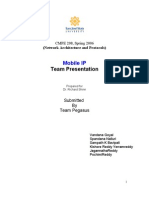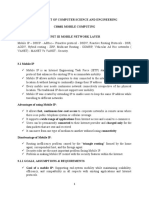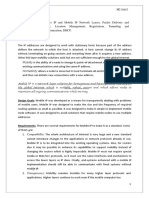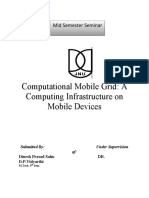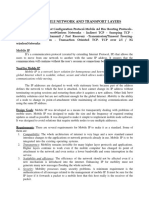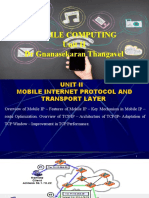Gur Jeet
Gur Jeet
Uploaded by
Fawzi FattaniCopyright:
Available Formats
Gur Jeet
Gur Jeet
Uploaded by
Fawzi FattaniCopyright
Available Formats
Share this document
Did you find this document useful?
Is this content inappropriate?
Copyright:
Available Formats
Gur Jeet
Gur Jeet
Uploaded by
Fawzi FattaniCopyright:
Available Formats
ISSN : 2230-7109 (Online) | ISSN : 2230-9543 (Print)
IJECT Vol. 2, IssuE 4, oCT. - DEC. 2011
Roaming Between Cellular IP Networks
1 1
Dept. of CSE, Desh Bhagat Institute of Engg & Management Moga, India 2 Dept. of ECE, Satyam Polytechnic & Pharmacy College, Amritsar, India
Gurjeet Singh, 2Navneet Kaur
Abstract Internet uses the Internet Protocol version 4 (IPv4) in the network layer. IPv4 assumes that computers are always attached to their networks without the possibility to communicate if they move to a remote location. Mobile IP is an extension to IPv4 that permits the once fixed terminal to visit a foreign network and to maintain seamless communication without changing its IP number. However, Mobile IP presents difficulties such as the routing scheme and the need for registration of the mobile terminal with its Home Agent every time it migrates to a new network. Some proposals have been developed that aim to minimize the number of registrations when the mobile terminal is within a limited area. For example, Cellular IP applies mobility management functions of cellular systems within a network domain, but when the mobile device is migrating between two domains, the registration follows Mobile IP. This paper proposes a functional entity to locate mobile terminals when roaming between Cellular IP networks. The cellular infrastructure is used in this proposal to benefit from paging and passive connectivity features that are absent in Mobile IP. Keywords Cellular systems, Cellular IP, mobile systems, Mobile IP, mobility management functions, wireless local area networks. I. Introduction Mobile devices have the ability to handle Internet services, in environments such as cellular systems and wireless local area networks (WLAN). Cellular systems provide a large coverage area to the mobile users who profit from voice and data communications. On the other hand, in WLANs, mobile devices are connected to a local area network that can offer a direct access to the Internet. In this paper, mobility principles from cellular systems are applied to reduce the amount of registrations that are necessary to keep track of a mobile terminal position while the mobile user is roaming between Cellular IP networks. The proposal challenge is to use the benefits of a well-structured cellular infrastructure with wellestablished roaming agreements among WLANs. The terminal location needs to be determined only when there is data to be received. Likewise, the terminal may be always ready to connect to the network if it needs to transmit without having to establish previous registrations with its home network. II. Internet Mobility A. Mobile IP The Mobile Internet Protocol (Mobile IP) is an extension to the Internet Protocol proposed by the Internet Engineering Task Force (IETF) that addresses this issue. It enables mobile computers to stay connected to the Internet regardless of their location and without changing their IP address. In short, the addition of the following entities gives support to mobility in IPv4:
Fig. 1: Routing in Mobile IP 1. Home Agent (HA) Home Agent is a router in the home network with the following functions: registration of the mobile device when it is away; interception of received data and data delivery through a tunnel to the foreign network. This tunnel may be created, for instance, using IP encapsulation within IP. 2. Foreign Agent (FA) Foreign Agent is a router in the visited network that gives an address to the mobile device and has the function to desencapsulate data sent by the Home Agent. It is also a passive component in the registration procedure, relaying the Mobile Hosts requests to the Home Agent. 3. Mobile Host (MH) Mobile Host is the terminal visiting a foreign network. In order to communicate properly, it must have an address on the new network. This address is called Care-of Address (CoA) and may be an address of the Foreign Agent or an address externally obtained (e.g., by Dynamic Host Configuration Protocol). In this case, it is called Co-located Care-of Address. 4. Correspondent Node (CN) Corresponding Node is a host that the Mobile Host is currently communicating with. Three related functions are performed by Mobile IP: Agent Discovery, Registration and Tunneling. Agent Discovery begins when the Mobile Host (MH) arrives on a foreign network and receives agent advertisement messages. If it wants, MH may solicit such messages. After obtaining an address to be used on that network, the MH tries to register with its HA. This registration can be done by the MH itself in case of obtaining a Co-located Care-of Address or through the FA, when the address belongs to the FA. After that, all packets sent to the MH are intercepted by the HA and sent through a tunnel between the HA and the Care-of-Address. B. Cellular IP
w w w. i j e c t. o r g
InternatIonal Journal of electronIcs & communIcatIon technology
217
IJECT Vol. 2, IssuE 4, oCT. - DEC. 2011
ISSN : 2230-7109 (Online) | ISSN : 2230-9543 (Print)
Cellular IP (CIP) proposes mobility within a local access network, assuming that a random access protocol is present on the air interface. The access network is connected to the Internet through a common gateway to all nodes. While in a Cellular IP network, the Mobile Host does not need to register when roaming between paging areas. Fig. 2, shows the architecture of a Cellular IP network. Base stations (BSs) periodically send beacon signals that allow mobile hosts to identify the nearest network. Packages are transmitted to the base station and forwarded to the gateway. While data packages from the Mobile Host go through a node, a table is updated with the identification of the MH that has sent the package and the neighbor from which it was received. This table will keep track of the routing information for the MH. When packages need to be sent to a MH, they are routed according to those tables. When a MH goes out of an access network, it becomes unavailable until finding another access network and registering to it according to the Mobile IP procedure. III. Macromobility Management Function Macromobility management function is responsible for managing mobility when mobile devices are roaming between Cellular IP micromobility areas. This entity is called Macromobility Management Function (MMF) and it acts as a gateway to the MHs.
Once the Mobile Host is out of the visited network, it must send packets with location update. For this purpose, it may utilize base stations of the existing cellular networks. These packets are relayed to the MMF, which will update its database. When the Home Agent needs to send data to the Mobile Host and does not have an entry in its routing table, it shall consult the MMF that will give the current location of the MH. If it is still migrating between two networks, the MMF itself may act as a gateway for that region and the registration request is made. The Mobile Host registers with its HA and utilizes the MMF IP address as Care-of Address. Therefore, the MMF becomes the end of the tunnel for the data that will come from the Home Agent as shown in Fig. 3. In order to communicate with WLAN devices and the cellular telephony system, the mobile devices must have a dual adapter able to recognize different base stations signals and change its behavior accordingly. As soon as it achieves a new micromobility region, the Mobile Host tries to register with the gateway for the new network, releasing the external network resources. During the registration procedure, the new location and the Care-of Address are sent to the Home Agent. A new tunnel is established and this information is also sent to the MMF for a location update of its database.
Fig. 3: A Foreign Agents in the Cellular Network Fig. 2: Cellular IP Network The MMF main function is to keep track of mobile hosts when they are visiting another network. Features such as passive connectivity and paging are now used in a macromobility scenario. These features are included in the Cellular IP proposal and they are absent in Mobile IP. If there is no data to transmit, the Mobile Host does not have to register with an agent or to be reachable by its Home Agent. This passive connectivity feature avoids resource consumption and it saves bandwidth. When the network receives data to a certain Mobile Host, the Home Agent intercepts them and it is necessary to find this host using the paging function. So, in order to become passively connected to the network, the Mobile Host must periodically send packets that update its location. This proposal assumes that Cellular IP is used for micromobility. In a micromobility area, the Mobile Host updates its location using paging-update packets, as proposed by Cellular IP. As long as it notices a new Mobile Host in its local area network, the gateway for the access network sends this information to the MMF that updates its database. When the Mobile Host leaves this local area, the timeout period expires and the gateway sends this new information to the MMF that becomes aware that the Mobile Host is not visiting that network anymore. IV. Conclusion In short, our main conclusion is that, if it is possible to transfer signalling information between the entities present in cellular systems and the gateways present in WLANs networks, it is also possible to, through the IP network, keep the Home Agents aware of the location of their mobile devices. The reuse of features such as paging allows the network to look for the Mobile Host every time data have to be sent to it even if the MH is roaming between CIP networks. References [1] Carli, M., Neri, A., Picci, A.R.,"Mobile IP and Cellular IP integration for inter access networks handoff", Communications 2001. ICC 2001. IEEE International Conference on, Vol. 8, 2001. [2] Campbell, A. et al., "Design, Implementation, and Evaluation of Cellular IP", IEEE Personal Communications, August, 2006. [3] Pandya, R., "Mobile and Personal Communication Systems and Services", IEEE Press series on digital & mobile communication, 2008. [4] Perkins, C., "IP Mobility Support for IPv4", IETF RFC 3220, 2008.
w w w. i j e c t. o r g
218
InternatIonal Journal of electronIcs & communIcatIon technology
ISSN : 2230-7109 (Online) | ISSN : 2230-9543 (Print)
IJECT Vol. 2, IssuE 4, oCT. - DEC. 2011
[5] Teughels, E Van Lil, A. Van de Capelle, "Mobility control beyond 3G systems", Communications and Vehicular Technology, 2009. [6] Wong, K. Daniel, "Archictecture Alternatives for Integrating Cellular IP and Mobile IP", Performance, Computing, and Communications Conference, 2009, 21st IEEE International 2009. Er. Gurjeet Singh is equipped with an extraordinary caliber and appreciable academic potency. He did his M.Tech (CSE) from Lovely Professional University, Phagwara. Now he is pursuing Ph.D in Network Security. Currently he is working as Assistant Professor, Deptt of Computer Science & Engineering at Desh Bhagat Institute of Engineering & Management, Moga. His research interest is in Mobile Adhoc Networks & Network Security. He is a life member of Indian Society for Technical Education (ISTE). He is also a Reviewer of International Journal of Computer Science & Information Technology and International Journal of Electronics & Communication Technology. He has published 40 National & International research papers in journals and conferences as well as 27 highly acclaimed text & research books. He has attended & organized various Short Term/ FDP/Workshop programs. He has a teaching experience of 4 years. Er.Navneet Kaur is working as a Sr.Lecturer at Satyam Polytechnic & Pharmacy College Amritsar. She has done his B.Tech(ECE) form Baba Kuma Singh Ji Engineering College, Amritsar and now Pursuing M.Tech(ECE) from DAVIET Jalandhar. Her research interest is in Digital Electronics & Microprocessor. She has also published his research papers at national level conferences. She has a teaching experience of 3 years.
w w w. i j e c t. o r g
InternatIonal Journal of electronIcs & communIcatIon technology
219
You might also like
- Training Offer For Network en PDFDocument60 pagesTraining Offer For Network en PDFMuthuVelNo ratings yet
- Cellular IP: 2 Cellular Internet 3 Protocol Overview 3.1 Features 3.2 Routing 3.3 Handoff 3.4 Paging ReferencesDocument6 pagesCellular IP: 2 Cellular Internet 3 Protocol Overview 3.1 Features 3.2 Routing 3.3 Handoff 3.4 Paging ReferencesVijay UkaniNo ratings yet
- Internet and Multimedia TechnologyDocument10 pagesInternet and Multimedia TechnologySwarnim ShuklaNo ratings yet
- Mobility Management For Ip-Based Wireless Networks: Horizontal Handoff. Intersystem or InterdomainDocument6 pagesMobility Management For Ip-Based Wireless Networks: Horizontal Handoff. Intersystem or InterdomaincancellettoseiNo ratings yet
- Mobile IP: A Complete Solution For Emerging CommunicationsDocument3 pagesMobile IP: A Complete Solution For Emerging CommunicationsmonumunduriNo ratings yet
- A Review On Mobile Ip Connectivity and Its Qos: Adrian StoicaDocument16 pagesA Review On Mobile Ip Connectivity and Its Qos: Adrian Stoicasuper34ccNo ratings yet
- Mobile IP 2010Document10 pagesMobile IP 2010Oira AlexNo ratings yet
- Mobile IpDocument3 pagesMobile IpMrinal NinaweNo ratings yet
- UNIT-III: Mobile Networking: Virtual IP Protocols - Loose Source Routing Protocols - Mobile IP - CDPD - GPRSDocument20 pagesUNIT-III: Mobile Networking: Virtual IP Protocols - Loose Source Routing Protocols - Mobile IP - CDPD - GPRSkannyNo ratings yet
- An Exposition On Wireless/Ip InterworkingDocument33 pagesAn Exposition On Wireless/Ip InterworkingKhalid MahmoodNo ratings yet
- Internet Connectivity For Ad Hoc Mobile NetworksDocument15 pagesInternet Connectivity For Ad Hoc Mobile NetworkssavitharohiniNo ratings yet
- Mobile IP: Internet Protocol SuiteDocument5 pagesMobile IP: Internet Protocol Suiteksuresh0055599No ratings yet
- MIP Report 1.1Document15 pagesMIP Report 1.1Abdul Rehman HabibaniNo ratings yet
- Dept of CSE, P.E.S.C.E.,Mandya 1Document16 pagesDept of CSE, P.E.S.C.E.,Mandya 1Manasa GowdaNo ratings yet
- Mobile IP - Wikipedia, The Free EncyclopediaDocument4 pagesMobile IP - Wikipedia, The Free Encyclopediapokiri_20060% (1)
- Mobile IPDocument4 pagesMobile IPjim1234uNo ratings yet
- Ubicc-105 105Document9 pagesUbicc-105 105Usman TariqNo ratings yet
- 1RZ18MCA14-Harshith Kumar KDocument15 pages1RZ18MCA14-Harshith Kumar KHarshith KumarNo ratings yet
- Chapter 6 - Mobile Network LayerDocument23 pagesChapter 6 - Mobile Network LayerYawkal AddisNo ratings yet
- IPv4 Mobility SupportDocument8 pagesIPv4 Mobility SupportseventhsensegroupNo ratings yet
- Mobile IP Handoffs Among Multiple Internet Gateways in Mobile Ad Hoc NetworksDocument12 pagesMobile IP Handoffs Among Multiple Internet Gateways in Mobile Ad Hoc NetworksSatish NaiduNo ratings yet
- Mobile IP Network LayerDocument59 pagesMobile IP Network Layerabhilang836No ratings yet
- MC Iv UnitDocument3 pagesMC Iv UnitRanjith RKNo ratings yet
- Updated Chapter 6Document9 pagesUpdated Chapter 6kibertemesgen78No ratings yet
- Advanced Computer Networks1Document15 pagesAdvanced Computer Networks1Harshith KumarNo ratings yet
- MC Unit 3Document42 pagesMC Unit 3S DivyaNo ratings yet
- Unit-3 MCDocument23 pagesUnit-3 MCJohnpaulNo ratings yet
- MC R20 - Unit-3-Part1Document28 pagesMC R20 - Unit-3-Part1Yadavilli VinayNo ratings yet
- MC - Unit 3Document44 pagesMC - Unit 3Prathap SNo ratings yet
- Mobile Network LayerDocument25 pagesMobile Network LayerAmrendra Kumar Mishra100% (2)
- Mobility Is The Ability of A Node To Change Its Point-Of-Attachment While Maintaining AllDocument24 pagesMobility Is The Ability of A Node To Change Its Point-Of-Attachment While Maintaining Alltrinathtrinu1437No ratings yet
- Aim: Study WDN, Its Types and Cellular Network Theory: Wireless NetworkDocument12 pagesAim: Study WDN, Its Types and Cellular Network Theory: Wireless NetworkShekhar DahiyaNo ratings yet
- Unit 4Document63 pagesUnit 4ashwani tyagiNo ratings yet
- Unit IIDocument23 pagesUnit IIVidhyaNo ratings yet
- Mobility Is The Ability of A Node To Change Its Point-Of-Attachment While Maintaining AllDocument24 pagesMobility Is The Ability of A Node To Change Its Point-Of-Attachment While Maintaining AllDr. Sashi Kanth Reddy ANo ratings yet
- Wireless Communication Mobile IPDocument8 pagesWireless Communication Mobile IPmycatalystsNo ratings yet
- Wireless and Mobile Computing: University of GujratDocument42 pagesWireless and Mobile Computing: University of GujratIqra HanifNo ratings yet
- An Application of Genetic Algorithm in Mobile Ipv4 For Packet Loss OptimizationDocument5 pagesAn Application of Genetic Algorithm in Mobile Ipv4 For Packet Loss OptimizationInternational Journal of Application or Innovation in Engineering & ManagementNo ratings yet
- It6601 Mobile Computing 2 Marks With AnswersDocument24 pagesIt6601 Mobile Computing 2 Marks With AnswersPushpavalli Mohan100% (2)
- MC - Unit 3 NotesDocument44 pagesMC - Unit 3 Notesmagenterprises23No ratings yet
- Mobile Computing PaperDocument13 pagesMobile Computing PaperevilanubhavNo ratings yet
- Computational Mobile Grid: A Computing Infrastructure On Mobile DevicesDocument9 pagesComputational Mobile Grid: A Computing Infrastructure On Mobile DevicesDinesh SahuNo ratings yet
- MC Unit 4Document31 pagesMC Unit 4Kandimalla SrinadhNo ratings yet
- Mobile-IP Goals, Entities, Packet Delivery, Encapsulations, Tunnelling and DHCP (Unit-3)Document22 pagesMobile-IP Goals, Entities, Packet Delivery, Encapsulations, Tunnelling and DHCP (Unit-3)Mukesh88% (75)
- Comparison of IP Mobility SolutionsDocument13 pagesComparison of IP Mobility SolutionsChakravarthi ChittajalluNo ratings yet
- CN Module4 PDFDocument19 pagesCN Module4 PDFRakshith AcchuNo ratings yet
- MVR QB Unit 3Document26 pagesMVR QB Unit 3MEENAL AGRAWALNo ratings yet
- MC Unit3Document44 pagesMC Unit3SENTHIL VNo ratings yet
- Unit 2Document32 pagesUnit 2Shirley AndrinaNo ratings yet
- Experiment No. 3 Aim: TheoryDocument4 pagesExperiment No. 3 Aim: TheoryTradesmen JobsNo ratings yet
- Wireless Means Transmitting Signals Using Radio Waves As The Medium Instead of WiresDocument26 pagesWireless Means Transmitting Signals Using Radio Waves As The Medium Instead of WiresVani BaskaranNo ratings yet
- Mobile Internet Protocol: by Nithiyapriya .PDocument11 pagesMobile Internet Protocol: by Nithiyapriya .Pgeetanjali rajputNo ratings yet
- Mobile IP - Deployment After A Decade: Kishore Ramachandran Kishore@winlab - Rutgers.eduDocument6 pagesMobile IP - Deployment After A Decade: Kishore Ramachandran Kishore@winlab - Rutgers.edumazoheroNo ratings yet
- Performance Enhancement For Mipv6 Using An Efficient Handover MechanismDocument6 pagesPerformance Enhancement For Mipv6 Using An Efficient Handover MechanismInternational Journal of Application or Innovation in Engineering & ManagementNo ratings yet
- Future Wireless TechnologyDocument31 pagesFuture Wireless TechnologySandeep MahankaliNo ratings yet
- Mobile Computing Unit II DR Gnanasekaran ThangavelDocument51 pagesMobile Computing Unit II DR Gnanasekaran ThangavelK Gowsic GowsicNo ratings yet
- Mobile Communications - Unit IV - CheatsheetDocument3 pagesMobile Communications - Unit IV - CheatsheetscotpepNo ratings yet
- MC Unit3Document15 pagesMC Unit3Tanay NaikNo ratings yet
- Wireless Communication Solution1Document26 pagesWireless Communication Solution1Saurabh Nirala pandeyNo ratings yet
- Mobile Ip & Wap NotesDocument17 pagesMobile Ip & Wap NotesMelissa HobbsNo ratings yet
- 1.RBS 6000 WCDMA IntegrationDocument40 pages1.RBS 6000 WCDMA Integrationkarim-ahmedNo ratings yet
- Internet AccessDocument29 pagesInternet AccessRomeo ManaNo ratings yet
- Volte Advance Session On KPI & ParameterDocument25 pagesVolte Advance Session On KPI & Parametervicky_211287100% (4)
- 3 1 History of Networks Notes PDFDocument21 pages3 1 History of Networks Notes PDFprodigy1987No ratings yet
- XM Ac2100 DatasheetDocument2 pagesXM Ac2100 DatasheetAbdenago JesusNo ratings yet
- Fortigate Cook Book v5 PDFDocument384 pagesFortigate Cook Book v5 PDFThếSơnNguyễnNo ratings yet
- Dial PlanDocument148 pagesDial PlanAdeNo ratings yet
- Wireless and Mobile Networks: Computer Networking: A Top Down ApproachDocument10 pagesWireless and Mobile Networks: Computer Networking: A Top Down ApproachFasih ImranNo ratings yet
- Cisco Training by Rahul NademDocument53 pagesCisco Training by Rahul NademKishore ChowdaryNo ratings yet
- Diversity in MWDocument74 pagesDiversity in MWBIRENDRA BHARDWAJNo ratings yet
- Lecture 15Document9 pagesLecture 15Hussain NaushadNo ratings yet
- vUSN V100R017C00 ATP Test Cases Additional Property List (4G)Document15 pagesvUSN V100R017C00 ATP Test Cases Additional Property List (4G)Sang PengelanaNo ratings yet
- Freepbx / Asterisk On Raspberry Pi: Bcs Northamptonshire BranchDocument12 pagesFreepbx / Asterisk On Raspberry Pi: Bcs Northamptonshire BranchAlvaro ReyesNo ratings yet
- Configuration of ELAN Card of MADM As Layer 2 SwitchDocument2 pagesConfiguration of ELAN Card of MADM As Layer 2 SwitchAngad KumarNo ratings yet
- Optical Transport Network (OTN)Document40 pagesOptical Transport Network (OTN)MaheshNo ratings yet
- Cisco IOS Debug Command Reference - Commands M Through RDocument758 pagesCisco IOS Debug Command Reference - Commands M Through RscorcdNo ratings yet
- MisseDocument18 pagesMisseBryan Pila100% (1)
- LINKSYS Wusb54gsc Wireless-G LINKSYS by CiscoDocument38 pagesLINKSYS Wusb54gsc Wireless-G LINKSYS by CiscolizNo ratings yet
- Juniper Logs PPT 855Document28 pagesJuniper Logs PPT 855Duy Le Tran DucNo ratings yet
- AR400 Series Router: Installation and Safety GuideDocument54 pagesAR400 Series Router: Installation and Safety GuidepavlepcNo ratings yet
- Access - ListDocument43 pagesAccess - ListBrijesh YadavNo ratings yet
- IP ExercisesDocument18 pagesIP ExercisesacajahuaringaNo ratings yet
- Quickstart Guide of OpenVox GSM Gateway vs-GW1600 Series With ClusteringDocument9 pagesQuickstart Guide of OpenVox GSM Gateway vs-GW1600 Series With Clusteringj3palaciosNo ratings yet
- Mobile Ad-Hoc Networks: Manets)Document17 pagesMobile Ad-Hoc Networks: Manets)Shievangi Sharma100% (1)
- Mobile Communication Systems: Part III-Traffic EngineeringDocument50 pagesMobile Communication Systems: Part III-Traffic EngineeringmuralitejasNo ratings yet
- Spec PMP450i AP 10022019Document3 pagesSpec PMP450i AP 10022019Edi SuryanaNo ratings yet
- Libra MAX-SS 5X00 PDFDocument2 pagesLibra MAX-SS 5X00 PDFJohn C. YoungNo ratings yet
- FTTX Solutions BrochureDocument12 pagesFTTX Solutions BrochureWalter R. SchulzNo ratings yet
- BP Ahv NetworkingDocument58 pagesBP Ahv NetworkingDinaj AttanayakaNo ratings yet












